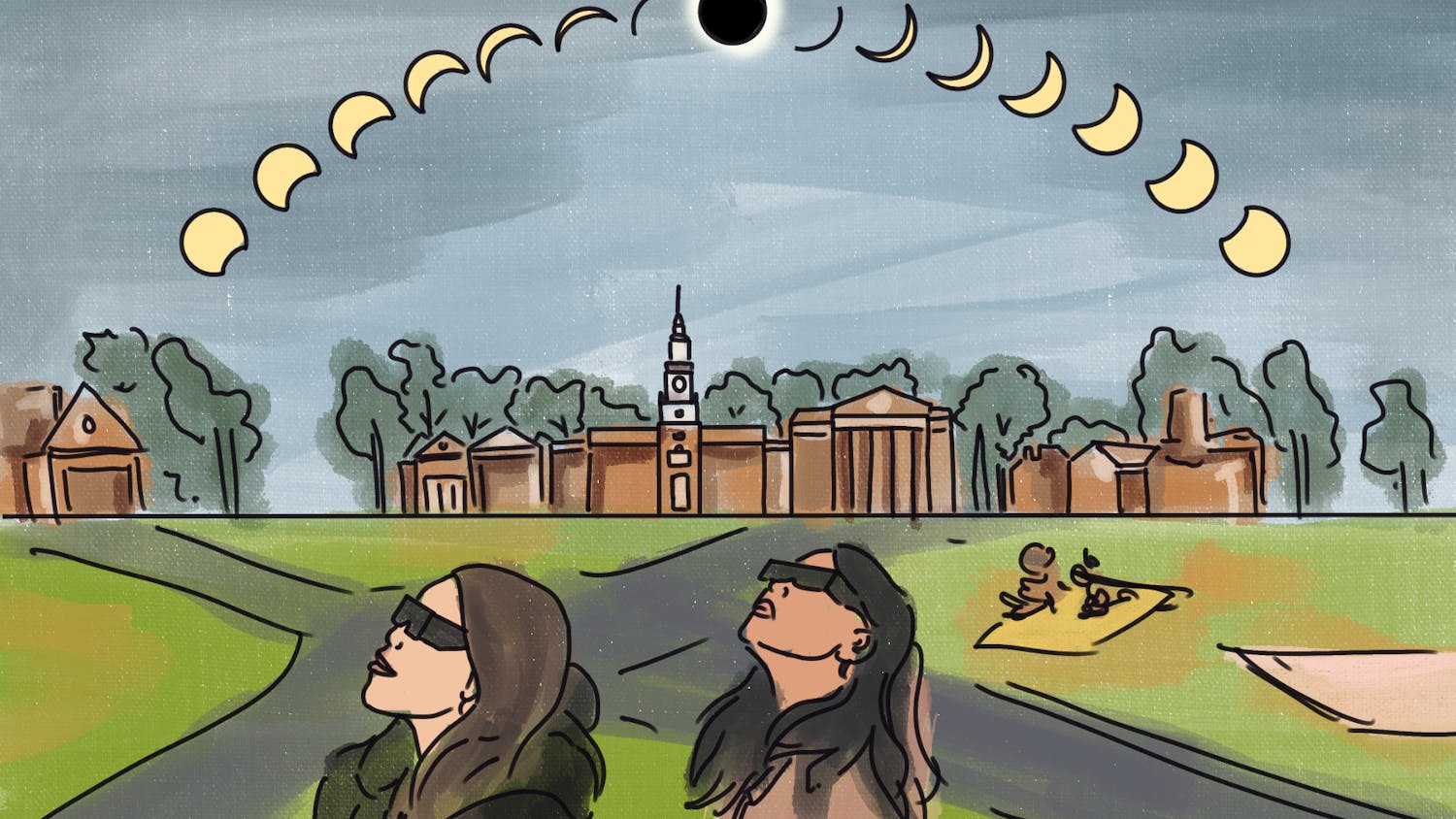“From Gurgl and Obergurgl to New Hampshire comes Dr. Wolfgang Schlitz. Touring the White Mountains, he sees Mount Washington, famous for high winds, terrific storms, many climbing tragedies.”
Those are the opening lines of Christopher Young’s 1935 comedy “Schlitz on Mount Washington,” the tale of an intrepid man from Austria who, upon setting his sights on Mount Washington, becomes determined to conquer it. Along the way, Schlitz suffers from inclement weather, poor planning and plenty of bad luck, but he remains determined to finish what he set out to accomplish.
Schlitz would be just another obscure black-and-white film from the ‘30s if it weren’t for its special place within Dartmouth culture: it’s the film that gets shown to new students every year at the Moosilauke Ravine Lodge, during the last night of First-Year Trips. To add to its memorability, student volunteers stationed at Moosilauke during Trips, known as “Lodj Croo,” scream out a set of bizarre callbacks throughout the film — not unlike the audience chants for which “The Rocky Horror Picture Show” is best known.
I assumed, as many students have, that Schlitz must have been produced by a Dartmouth alumnus. Why else would it have become a Trips tradition? So you can imagine my surprise when I spoke to the librarians at the Rauner Special Collections Library and learned that Christopher Young, the producer and star of the movie, couldn’t be found in any of the files. Neither Lowell Thomas, the film’s narrator, nor Winston Pote, the cinematographer, could be found in Rauner, either.
Following a tip from Rory Gawler ’05, the assistant director of outdoor programs at the Dartmouth Outing Club, I emailed the New England Ski Museum in Franconia, New Hampshire — they had supposedly been in charge of digitizing the original film, and I was hoping someone at the museum would be able to shed light on the origins of Schlitz. I was connected with Rick Moulton, a documentary filmmaker and producer who directs his own studio, Keystone Productions.
Moulton made a film in the early ’80s called “Legends of American Skiing,” and while going through Dartmouth’s collection of ski films, he came across the works of Christopher Young in an attic. As it turned out, Young wasn’t a Dartmouth alumnus — he had graduated from the University of Pennsylvania, as had his father. It was Young’s wife, Mary Bird Young, who had donated the films to Dartmouth after her husband passed away. Moulton believes that she did this because of his love for skiing.
“I think his wife … gave his films to Dartmouth because of Chris’s love for skiing and the fact that she knew he had been involved with the Outing Club in the early days of skiing in the ’30s up on Mount Washington,” Moulton said.
Moulton explained that Young was well-known as a surrealist filmmaker, and while there are tastes of his signature surrealism on Schlitz — such as when Doctor Schlitz hallucinates a ballerina in the fog — his 1941 film “Object Lessons” and its sequel “Subject Lessons” are much better examples of his characteristic style.
Winston Pote was in charge of filming so that Young could star as the protagonist of his own film, though Schlitz wasn’t the only thing that Pote was known for. Moulton described Pote as the “most renowned mountain filmmaker near Mount Washington” at the time, and soon after filming Schlitz, he would become a photographer for the 10th Mountain Division during World War II.
Lowell Thomas, the film’s narrator, is perhaps the most well-known of the people who contributed to Schlitz. Moulton did not hesitate to name Thomas “the voice of news in America” when the film came out; he was the “foremost broadcaster” of NBC and CBS, who happened to be skiing at Tuckerman Ravine when he fortuitously bumped into Young and Pote. Inspired by the aspiring young filmmaker, Thomas decided to lend his voice to the project.
When asked what he wished more students knew about Schlitz, Moulton simply pointed to the “Herculean effort” of making a film like that in the 1930s.
“Everything had to be hauled up Mount Washington for the filming,” Moulton said. “35-millimeter film weighs a lot, and you’re talking about a cranked camera and a tripod all lugged up Mt. Washington. Staging those scenes in that weather … think about how many trips up Mount Washington it took!”
After learning more about Young’s life, it became increasingly clear that many of the scenes in Schlitz were inspired by his own experiences. For example, the story of how Young met his wife is as follows: he was skiing at Mount Mansfield in Vermont when he happened to lay eyes on Mary and immediately became enamored. He tried to follow her down the notorious “Nose Dive” when he fell and broke his ankle — as Mary just skied away. They didn’t see each other for another five months, but when they finally met up again, Mary vaguely remembered hearing about the broken angle.
In Schlitz, there are multiple scenes in which the main protagonist chases after women, including one in which he swoops down to rescue an out-of-control woman skiing down the mountain. He fails to catch her before she falls off the cliff, but the distressed Schlitz peers down and quickly learns that there was never any woman in the first place — it was a puppet decoy strapped to skis, set up as a prank.
Such scenes aren’t always as well-received today, especially in the context of long-going fights against sexism and sexual assault. Hanover Vale ’20, who was on Lodj Croo in 2017 and was a trip leader this past summer, said that she felt uncomfortable watching one scene in which Schlitz tries to make advances toward a group of women sitting underneath a waterfall, to the point where the women try to run away. She added that the subtext was very sexual, and the narrator’s commentary of “After her! The other one!” didn’t help.
Vale recognized the importance of remaining critical, and even suggested that future Lodj Croos possibly introduce the film more intentionally at Moosilauke, acknowledging some of the more problematic aspects of the film and leaving room for discussion afterwards. At the same time, however, she acknowledged the importance of not erasing an institution’s past, and she doesn’t think that the future of Schlitz is in her hands, anyway.
Even if certain aspects of the film are dated and problematic, Vale still remembers the beauty of her first time experiencing the film and admitted that it’s something “you get into by the end.”
“I remember just sitting there in this state of complete confusion,” Vale said. “A kind of joyous confusion when there’s this super old film from the ’30s being shown and all these upperclassmen screaming random things at the screen.”
Jake Klein ’20, who, similarly to Vale, was on Lodj Croo in 2017 and was a trip leader last summer, has very fond memories of watching Schlitz. He remembered that his freshman year, he was on the very first section of Trips, which made his Schlitz-viewing experience a little more disorienting.
“I actually thought [the movie] was the cleverest, funniest thing as a freshman,” Klein said. “I was on Section A, so Lodj Croo, which does their chants throughout it, didn’t even know their commands that well, but I thought it was funny.”
Klein’s said that his favorite parts of the film are the old-timey expressions used throughout, such as “Oh, rats!” and “That’s a fine windbreaker!”
His least favorite part, on the other hand, is the middle of the film, which he thinks is slower and blander than the beginning and end.
Something else that Klein doesn’t love about the film is its unclear link to Dartmouth history and culture. According to David Hooke ’84 in his book “Reaching That Peak: 75 Years of the Dartmouth Outing Club,” the film was “rediscovered in the 1960s” and, by the 1970s, had begun to play “an integral role in the Freshman Trips program.” Considering that Christopher Young wasn’t a Dartmouth alumnus, however, the film’s connection to Dartmouth history may end there.
The history of “Schlitz on Mount Washington” aside — is it a tradition worth keeping?
Klein admitted that, while he personally enjoys the film, it might not be the best use of Lodj Croo’s time during Trips.
“To be honest, as much as I love Schlitz — I watch the movie in my free time, and I have it on my computer — I think the time could probably be better used with something a little more relaxing or meaningful,” Klein said. “Schlitz is fun, but I don’t think it’s doing a ton to help trippees transition to Dartmouth.”
Gawler, who was the one that recommended I contact the New England Ski Museum, has his own relationship with the film as an alumnus. He explained that one of the challenges of his position is not being sure how, if at all, he should play a role in preserving the tradition. If the film were to start fading away from Dartmouth culture, should he try to keep it alive or instead let it fade?
He admitted that he appreciated the fun that comes with being able to reference movies in everyday conversation, and even today, he still references some of the Lodj Croo callbacks from his year when talking to friends. He also explained that some of the callbacks have changed over the years, to reflect changes in both pop culture and Dartmouth culture.
Gawler elaborated that some of the older callbacks from previous years would be considered in bad taste today, though some alumni continue to repeat them when they visit.
“Occasionally, what will happen is that during Alumni Reunions, we’ll be asked to play [Schlitz] at the Moosilauke Ravine Lodge, and a couple of people who were on Lodj Croo or heavily involved with the DOC will do some of the callbacks,” Gawler said. “I’ve seen that happen a couple of times, and some of the stuff is really pretty inappropriate and speaks to the culture of campus back then — before coeducation, for example.”
So, if Schlitz were to be replaced with something else, what would that “something else” look like? Gawler suggested a video highlighting the meaningful values and educational opportunities of the DOC, in contrast to the current DOC video shown at Moosilauke, which is instead more of an exhilarating highlights reel of different DOC activities.
Klein first suggested creating a new 20-minute-long comedy film before thinking of possibly using that time to better support trippees, perhaps in the form of filmed Q&A-style interviews with students.
Vale proposed that perhaps Dr. Seuss’s “The Lorax” could be a modern iteration of Schlitz. She explained that it’s a meaningful film which has a very strong, clear link to one of Dartmouth’s most famous alumni.
Regardless of Schlitz’s past in the context of the First-Year Trips program, it’s undeniable that the film has become a sort of cult classic within the Dartmouth community. Future Trips directorates will continue to discuss its place and value within the program, but for students who went on Trips — as confused, exhausted first-years or Croo members with every callback committed to memory — its effect on their Dartmouth experience is already there.
Perhaps the paradoxical nature of “Schlitz on Mount Washington” as a cherished film whose link to Dartmouth is less direct than many assume, is best characterized by the final callback of the film. At the end of the movie, as Dr. Schlitz is driving away into the horizion, the narrator remarks: “Even he hates to see you go.”
In perfect unison, the members of Lodj Croo shout back: “But he loves to watch you leave!”



